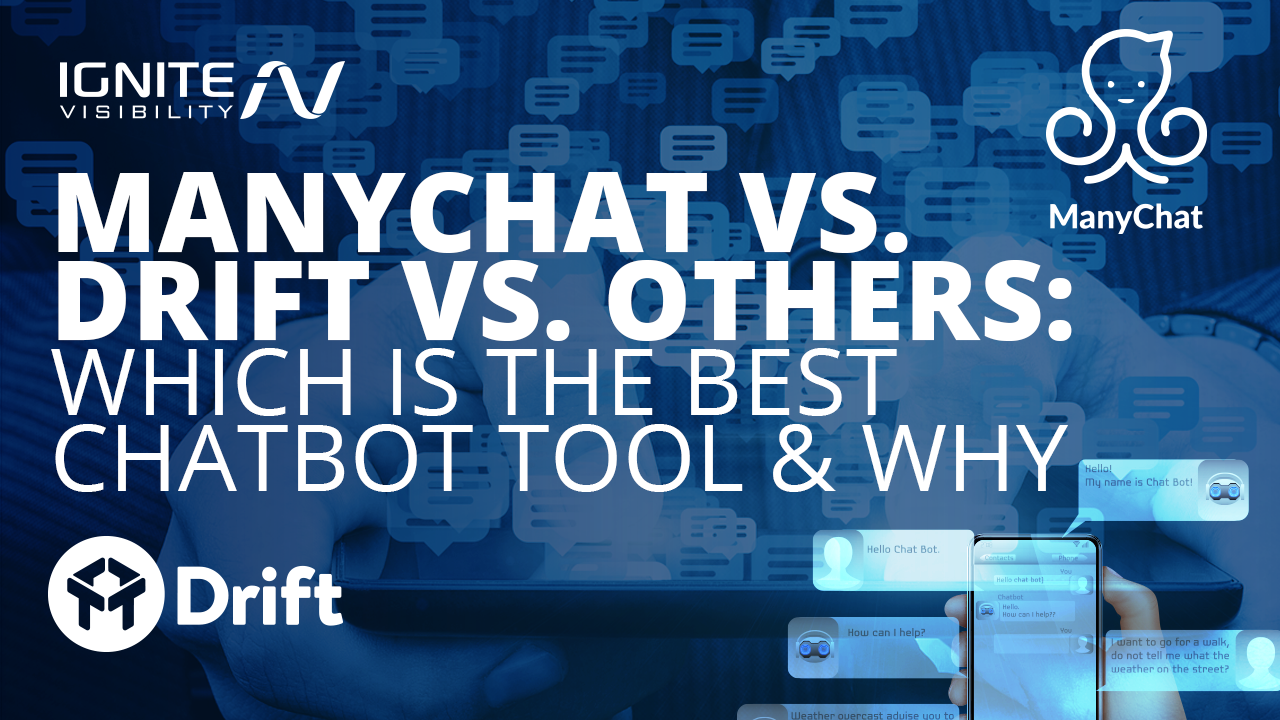Today’s chatbots are getting so good they’re shaking up sales and marketing as we know it.
But to help meet your business goals, you need to select the best chatbot builder. This article looks at some of the best chatbot tools and where you might use them.
What You’ll Learn:
- The benefits of chatbots, and why they’re sticking around
- The differences between Facebook Messenger chatbots and native chatbots
- The best chatbot tools (and who they’re best for)
- Other considerations when choosing the best chatbot tool
Why Chatbots are Sticking Around
Chatbot utility extends well beyond their use as a support tool. They allow brands to automate conversations that take up time better spent on other efforts.
They also help brands generate leads and revenue. They guide users toward solving problems and engage with users in a way other channels just can’t compete with. But the real gold mine is access to a wealth of contextual data.
Chatbots collect information that uncovers the “why” behind behavioral patterns or survey responses. Savvy marketers know that bots, whether on Facebook or a website, allow them to understand the intent and motivations of their audience like never before.
And, on the business side, they can be serious money-savers. Chatbots Life reports that Businesses spend nearly $1.3 trillion customer service-related requests. But reportedly, using chatbots can help you save up to 30% of this, and Juniper Research predicts that by 2022, brands will experience 8 billion in cost savings from the use of chatbots.
As the use of AI in marketing continues to rise, it only makes sense that more and more companies will continue to adopt chatbot technology. According to the Gartner Report, 85% of customer interactions will be handled without a human agent by 2020.
But beyond their benefits to brands, chatbots are quickly becoming a preferred method of communication for customers.
The chart below represents the benefits consumers see in the use of chatbots, and the results are similar regardless of age demographic. As marketers, we can take this to mean that chatbots have mass appeal, and will largely be welcomed by consumers regardless of your target audience.
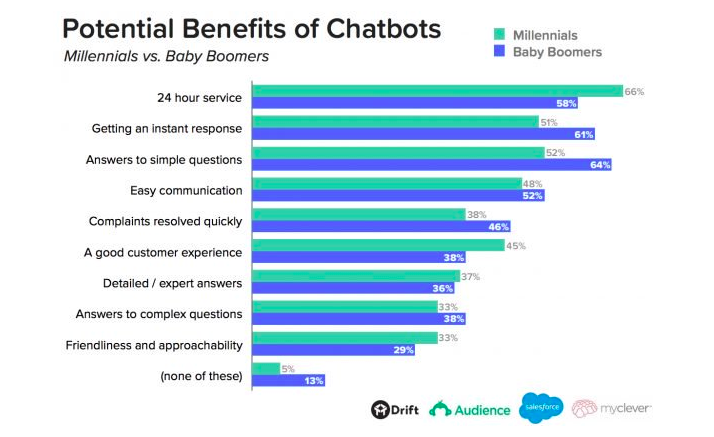
The best chatbot benefits, according to consumers
By now, you must be totally convinced that chatbots are a must in your marketing strategy (right?!).
Here, we’ll talk more about how bots can fit into your strategy:
Native Chatbots vs. Facebook Messenger Bots
There are a few things you’ll want to consider before deciding on which is the best chatbot for business. The first is whether you want to create a Facebook Messenger Bot or a native chatbot.
The biggest difference between the two bot types is the location. Facebook bots live only within the Messenger platform. Native chatbots live on your website.
Beyond the obvious, there are a few pros and cons associated with each type. Here’s the quick rundown of why you might choose one bot platform over another.
Facebook Messenger
Facebook Messenger bots are versatile, Facebook Messenger bots are versatile in that they work with a wide range of business types and are great for driving engagement on a brand’s Facebook page.
- Use Chat to Direct Consumers to Your Product Page–Once you’ve warmed up your audience a bit, you can direct them toward product pages. So long as you don’t approach this as a high-pressure sales pitch, this could be a good option for e-commerce brands to promote their wares.
- Reach Customers Where they Already Are–Facebook Messenger currently has 1.3 billion monthly active users. Bringing interactive chat into a platform your audience is already using removes the need for consumers to visit your website.
- Collect Data–When people interact with your Messenger bot, they provide more information than you’d get from using a lead generation form. What’s great about chat data is, you’ll get free form feedback that you can combine with the behavioral and demographic insights within the Facebook Ad dashboard.
- Qualify Leads–Adding Facebook Messenger bots into your marketing strategy allows you to qualify leads directly inside the platform. You can do this by programming your bots to ask a series of qualifying questions before you initiate a conversation with a prospect or launch a marketing campaign.
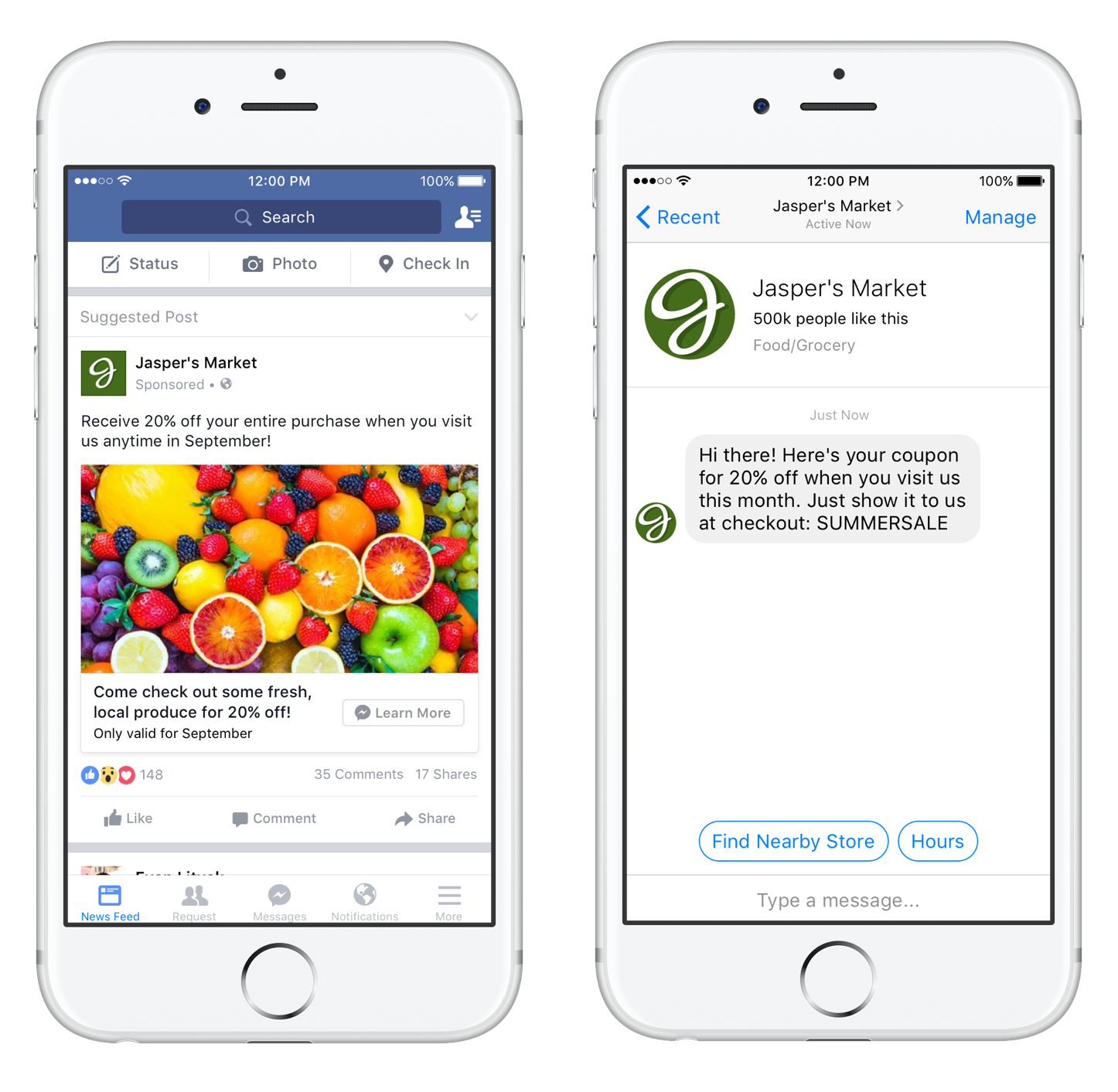
Facebook Messenger is the best Chatbot option if you want to integrate with social advertising
Before you set up a Facebook Messenger bot, it’s important to understand that you’ll get the most out of your bot by pairing it up with other Facebook advertising methods. Add the click-to-chat button to your product page, on your website, and in your paid ad campaigns to drive users to your bot.
Native Chatbots
Native chatbots, by contrast, offer a customizable experience, beyond what you can create for Messenger. You’ll also have the benefit of using the chatbot to get more out of your website. For instance, if a user is looking at a pricing page, you can use your chatbot to ask the visitor if they’d like to book a demo.
As with Facebook-based bots, your native chatbot can qualify leads, help visitors find relevant content, and collect information you can use in later marketing campaigns.
Here are a few advantages you’ll get from using a native bot:
- Great for brands that don’t have a huge Facebook presence—Look, Facebook isn’t exactly the best option for every kind of brand. In the B2B space, brands may have better luck with platforms like LinkedIn or Twitter.
- A new kind of lead magnet—Native chatbots can be used as a replacement for traditional forms or lead magnets. For example, you might run paid ads on LinkedIn or Google designed to attract a new audience. Once the lead lands on the site, you can greet them with a chatbot that presents an initial offer—which might invite them to join a mailing list or look at a piece of content.
- Allows for data collection—Bots allow brands to collect free form answers to questions about need or preferences. While on the site, you can learn more about the lead’s intent, and present offers that fit that person’s need. What’s more, that data can be used to create audience profiles in Google Ads or as the basis of a paid media strategy.
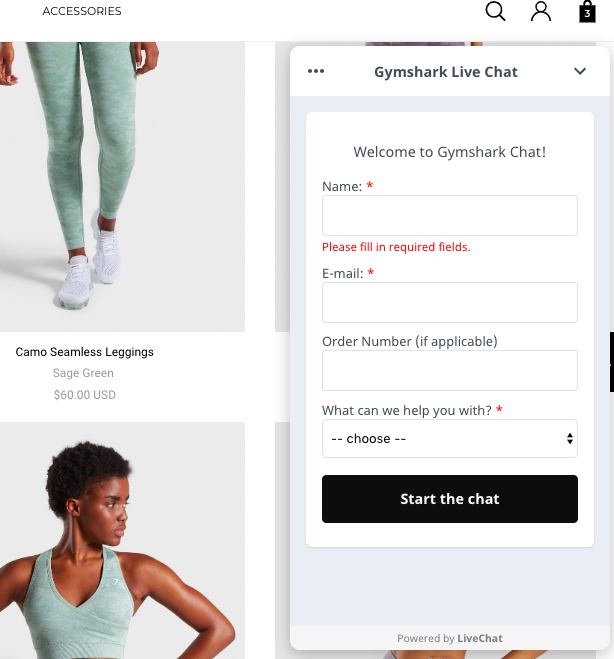
Native bots are the best chatbots for for collecting customer data
There’s a lot of crossover between native bots and Messenger bots.
Both allow you to collect data for later marketing efforts—personalized recommendations, tailored campaigns, etc.—and both qualify leads, and allow you to provide better customer service.
The Best Chatbot Tools – Which is Right for your Brand?
Once you’ve evaluated the pro’s and con’s of a Facebook bot versus a native bot, you’ll want to determine which tool will help you build the best chatbot for your brand.
Here, I’ve outlined a few of my favorites and who they’re best suited for.
Drift
Drift’s main selling point is that the chatbot platform does more than help users build the best chatbot that handles support questions. According to the website, Drift’s approach to marketing replaces lead gen forms with real-time conversations, allowing brands to capture and qualify leads within minutes.
The benefit there is brands can gain an understanding of what their prospects want. The data collected through the Drift bot can be integrated with other tools like Marketo, Hubspot, MailChimp, and others. This means marketers can develop more informed PPC and email marketing campaigns and sales can use chatbot data to create a
While we’re on the topic of Drift, it’s worth mentioning an integration called Clearbit.
Clearbit provides an extra layer of context for the people browsing your site. This is particularly useful for B2B sales and marketing, as it allows you to collect information about the company a visitor works for–size, industry, even the type of technology they use.
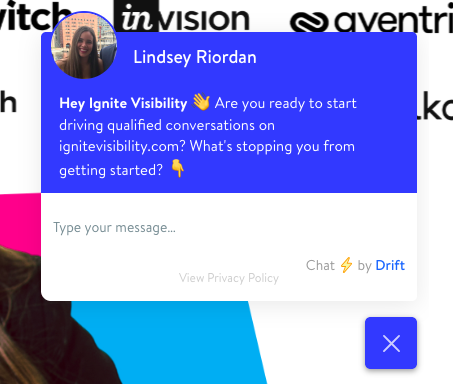
Drift could be the best chatbot for larger, B2B companies
Who Should Use Drift?
Drift makes the most sense for B2B companies that want more visibility between their sales and marketing departments. The Drift website mentions that the platform is perfect for brands engaging in what’s called Account-based Marketing or ABM. ABM is a sales strategy where marketing and sales work together to target an organization, rather than an individual prospect.
If that sounds like your biz, then this may be the best chatbot for you.
Best Chatbot Tools: ManyChat
People seem to like ManyChat because it’s easy to use and relatively affordable.
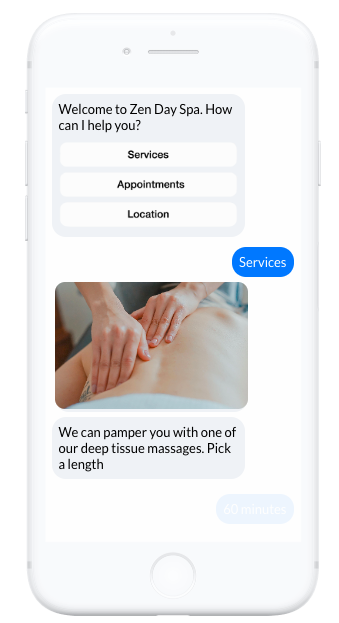
ManyChat may be the best chatbot option for smaller businesses
But— it’s important to note that this bot builder is restricted to use inside the Messenger platform only. Meaning you can’t use ManyChat on your website to collect leads as you can with Drift.
What we like about ManyChat is that it’s designed for users with very little experience with coding or programming. You can set up campaigns and sequences through their Basic Builder or Flow Builder.
The Flow Builder gives users a visual map of the chat starting with an intro message, then allowing you to add in conditions, questions, and develop nurture campaigns.
Who Should Use ManyChat?
ManyChat is ideal for small businesses, be it e-commerce, personal coaching, beauty, personal services, restaurants, and real estate.
Because ManyChat is both affordable and easy to use, this platform makes a lot of sense for brands that are pretty active on Messenger—it’s a great compliment to your Facebook ad campaigns and brick-and-mortar companies can use the platform to book reservations and appointments.
Again, because it’s limited to Messenger, ManyChat might not be the best chatbot tool for a large company or one selling high-consideration B2B products like enterprise software, IT equipment, and the like. We see this as a better fit for brands that work in a B2C setting and work directly with the end consumer.
Chatfuel
According to the website, 46% of Facebook’s bots were created using Chatfuel chatbots, and they do have some big-name clients from Nissan to LEGO, Levi’s, Greenpeace, and HelloFresh.
Chatfuel is similar to ManyChat in that this platform is designed for Facebook Messenger bots only.
That said, you can embed your Chatfuel bot into your website, so you’ll have similar functionality to a native chatbot. The only difference here is the user needs to log into their Messenger account to talk to the bot.
Who Should Use Chatfuel?
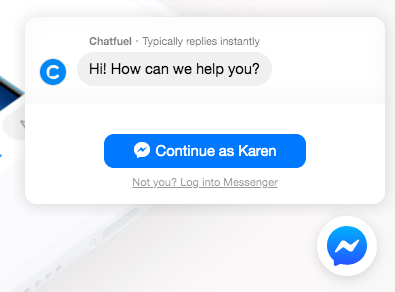
Chatfuel may be the best chatbot option for businesses who want to connect to Facebook Messenger
As we mentioned, Chatfuel seems to have a wide array of clients. Publications like TechCrunch use the platform, meaning you can use it to promote content or let subscribers know when there’s a new article they might like.
Other uses include customer support, the ability to promote your bot from Facebook ads, and more. Chatfuel can easily be designed to fit just about any type of business, but it’s going to work best for brands that already do a lot on Facebook.
We see Chatfuel as a tool that can help brands really level up their social media presence—connecting to ad campaigns, growing their subscriber list, or collecting information from potential leads.
Best Chatbots: Botsify
Botsify is another popular option on the chatbot scene and is designed to help you create intelligent chatbots for your website, Slack, or Facebook Messenger.
What’s nice about Botsify is that it’s an affordable solution—starting at $10 a month—that doesn’t limit your activity to inside Facebook Messenger. The AI-powered app comes with several useful features built right in. For one, Botsify can integrate with WordPress, Alexa, and Shopify.
Botsify also comes with something called Conversation Forms, which allows you to collect key details, like name, email, interest, and budget straight from the bot.
Like Drift, Botsify’s conversational approach to lead capture can shorten the sales cycle and improve the performance of marketing campaigns.
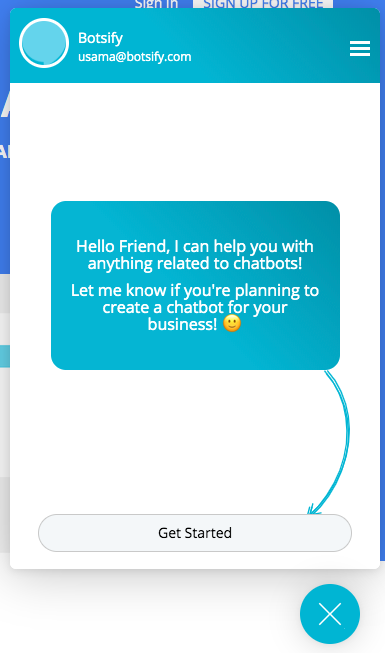
Botsify is an extremely versatile chatbot platform
Who Should Use Botsify?
Botsify is pretty darn versatile. Because the platform integrates with Shopify sites, we can see this being being the best chatbot choice for e-commerce brands, especially smaller ones where shop owners wear a whole lot of hats.
But, the site also features a tutorial walk-through for services companies. While services represents a huge spectrum of services, they’re specifically targeting brands that collect leads and nurture them.
The service is $50 a month for self-service accounts, and $300 a month for managed service accounts.
Vergic
Vergic is an AI-powered chatbot that offers customer support, chat-based transactions, and more. The key selling point with this platform is the ability to integrate with your CMS, CRM, and other business tools, allowing for a centralized hub for user data.
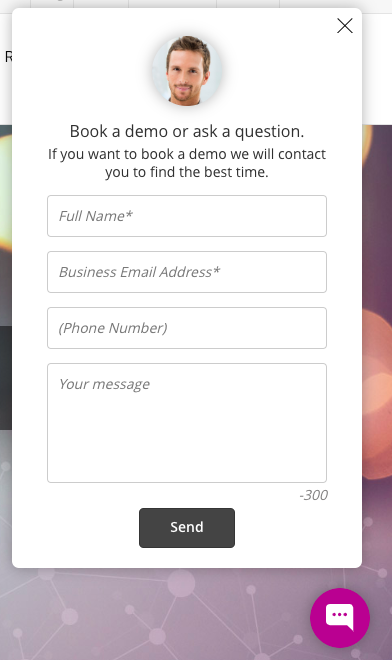
Vergic may be the best chatbot tool for larger, B2B companies
This platform is a native bot builder that works with your Microsoft, Google, or in-house AI solution to deliver a cohesive, frictionless customer experience across multiple touchpoints.
Vergic clearly does a lot, and according to the website their clients include leading insurance, IT, finance, and energy companies, as well as e-commerce.
Who Should Use Vergic?
Like Drift, Vergic appears to be designed for larger companies with more emphasis on the B2B customer. Unlike Drift, Vergic is more about CX than sales, so you’re looking at slightly different business goals.
Those goals include things like increasing customer lifetime value, collecting feedback, and gaining a 360-view of the customer experience that includes everything from how users interact with your website, on social channels, an in-person. Vergic is designed to qualify leads and uncover what drives customers–from behavior to interests, to what they say in reviews or tell the chatbot.
It’s important to note that compared to Chatfuel and ManyChat, Vergic is a comprehensive SaaS product best suited for companies with a substantial budget.
Other Considerations
In order to figure out what the best chatbot is for your business, you’ll need to figure out what you plan to use the bot for, as well as what your technical abilities are.
Some businesses want a basic bot that sends notifications to subscribers and offers basic support. For others, that’s just the tip of the iceberg.
As we touched on briefly in our recent article about Google’s Dialogflow, building a bot can be as simple as arranging a few steps, or as complex as creating a Natural Language Processing tool with several conditions built in.
Keep in mind that working with one of these chatbot platforms can help you do more without hiring a developer, but tools like Drift that are more sophisticated than Chatfuel cost more and still require some set-up and understanding on your end.
So, Which is the Best Chatbot?
While chatbots have been the subject of an awful lot of buzz, they’ve proven that they are here to stay—both on websites and inside Messenger.
In the end, there is no one “best” option, that all depends on whether you want to create a bot that guides users toward completing specific goals while on the website or as a supplement to your existing Facebook advertising stack.
E-commerce brands can benefit from using a Facebook Messenger bot, as you can answer questions and even allow users to buy items directly from the chatbot. That’s huge for companies that sell smaller items like clothing or beauty items, or items you might use in your home. ManyChat seems like the best bet here, based on the price point and ease of use.
For large B2B firms, Drift is our top pick. With the Clearbit integration and emphasis on sales and marketing functions, this tool is designed to help companies target big accounts and qualify leads before launching a big campaign or making a ton of cold calls.
So tell us, which do you think is the best chatbot for you?
